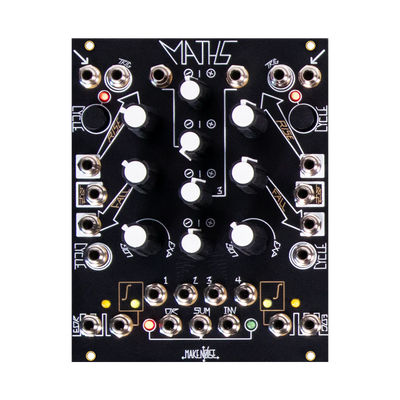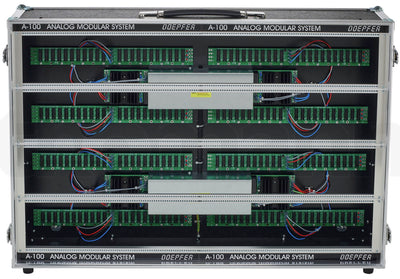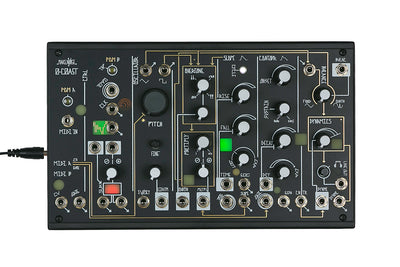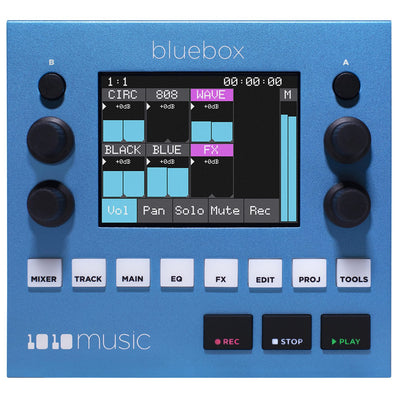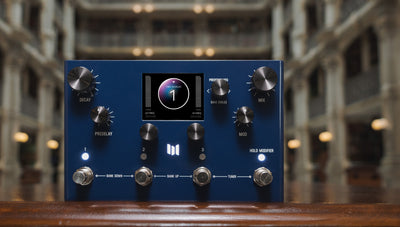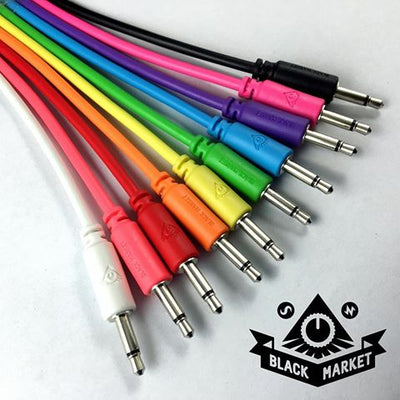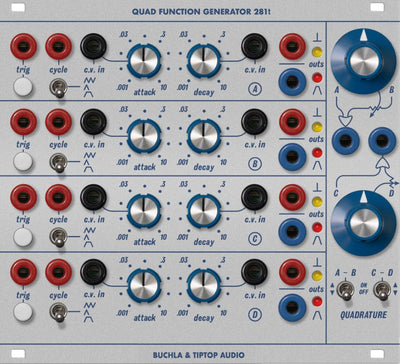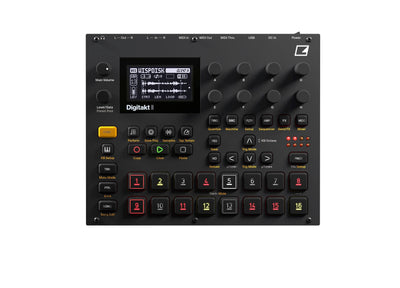The beating heart of the RH301 is the master clock, of which the tempo can be set by turning the Tempo knob, by tapping a tempo on the tap button, by syncing it to MIDI, DIN Sync or an external analog clock signal. The generated clock signal can be passed on via two clock outputs, two division outputs or via the MIDI Output and DIN Sync Output. An incoming MIDI signal can also be passed along via the MIDI Thru and MIDI Out sockets.
And that’s not all: besides having a master clock section, the RH301 is also fitted with a LFO which can be synced to the master clock, a division of the master clock, or run freely from 0,25 Hz to 260 Hz in five different waveforms: sine, triangle, square, S&H and noisine. This means the pedal can also be used as an lo-fi oscillator, when you turn the LFO up into the audible range. The LFO has two separate outputs on the patch bay: LFO out and LFO inverted out. Some of the features of the LFO can also be modulated via control voltage, the pedal boasts CV inputs for LFO SPEED, LFO RESET and LFO SYMMETRY.
The third main feature of the RH301 is an Envelope Generator which can easily be synced to the master clock, a division of the master clock or run in loop mode. Besides the normal controls for ATTACK, DECAY, SUSTAIN and RELEASE the pedal comes with a RANGE knob to change the time range of the envelope created. The envelope generator comes with a normal envelope output, but also an inverted envelope output and can be triggered by an external gate / trigger via the external gate Input.
KOMA Sensor
One of the features on your RH301 that you won’t find in any other pedal is the possibility to control the features of the pedals with the on board motion controller. Since its functions with infra red LEDs we call it the SENSOR. The motion controller can be used in many different ways. Technically speaking, it emits a CV signal (control voltage) which can be patched up with any CV receptive socket on the KOMA pedals and f.i. on your modular system. By moving your hand over the sensor you can control the parameters of the CV input you patched it up to. With the trimmer on the back of the pedal (it says SENSOR) you can change the sensitivity of the motion controller.
Technical Specifications & Manual
General Specs
- Casing: Powder coated aluminum casing, silk screened text and wooden side panels
- Dimensions: 23 cm x 20 cm x 5 cm (L x W x H) / 9″ x 9.8″ x 2″ (L x W x H)
- Net. Weight: 1000 gr / 2.2 lbs
- Shipping Weight: 1.5 kg. / 3.3 lbs including power adapter and User Manual
- Power requirements: 9V DC power adapter, 500mA min, center polarity negative (only use the KOMA adapter shipped with the pedal)
Knobs, Switches, Sliders and LED’s:

- TEMPO – Rotary control to set the tempo in Free mode
- DIVISION – Rotary switch to select one of 9 divisions/multiples of the master clock signal
- SOURCE SELECT – Slide switch to select the master clock sync source (Tap – Free – MIDI / DIN Sync / external analog clock synchronization)
- RATE – Rotary control to change the speed / division of the LFO
- SHAPE – Rotary switch to change the basic waveform of the LFO. Available waveforms are: Sine – Triangle – Square – S&H – Noisine
- SYMMETRY – Rotary control to change the symmetry of the LFO waveform
- LFO MODE – Slide switch to chose between synced or Hz (free running) mode for the LFO
- ATTACK – Rotary control to set the attack time of the envelope
- DECAY – Rotary control to set the decay time of the envelope
- SUSTAIN – Rotary control to set the level of the envelope while the gate is high
- RELEASE – Rotary control to set the release time of the envelope
- RANGE – Rotary control to change the time range on the A, D and R stages. By turning this knob clockwise the envelope becomes slower and fades from a snappy linear to a logarithmic behavior
- ENVELOPE MODE – Slide switch to chose between master clock sync – division sync – free running mode
- MASTER TEMPO LED – LED ring around the Tap/Start/Stop button
- LFO LED – LED indicator to display the LFO
- ENVELOPE LED – LED indicator to display the envelope
- LARGE BLACK BUTTON – Acts as a tap button in Tap mode or as start / stop / manual sync in the other master clock modes
- 2 IR EMITTERS, 1 IR RECEIVER – Calculates the distance between an object and the pedal and generates a CV signal according to the measured distance. The CV output of this sensor appears as a CV output on the patch bay, from where you can route it to the CV input of your desired, to-be-modulated feature
Average Clock Propagation delays
- Midi In → Midi Out < 1,2ms
- Midi In → Din Out < 1ms
- Ext/DIN In → Midi Out < 800µs
- Ext/DIN In → Din Out < 600µs
The In’s and Out’s of the RH301:

- CLOCK (x2) – Master clock output; square wave signal with 50% duty cycle
- DIVISION (x2) – Division output; square wave signal with 50% duty cycle
- EXT. CLOCK – CV input that accepts any rising edge trigger or gate
- LFO SPEED – CV input (0V – 5V) to control the rate / division of the LFO
- LFO RESET – Trigger/Gate input that resets the LFO on the rising edge
- ENV – CV output of the envelope signal (0V – 7.6V)
- ENV INV – CV output of the inverted envelope signal (7.6V – 0V)
- ENV GATE – CV input for an external envelope gate or trigger
- LFO – CV output for the LFO signal (0V – 7.6V)
- LFO INV – CV output for the inverted LFO signal (0V – 7.6V)
- LFO SYMM – CV input (0V – 5V) for controlling the symmetry of the LFO waveform
- SENSOR – CV output (0V – 8V) of the onboard motion sensor for usage with CV inputs on the pedal, other KOMA Elektronik pedals or other voltage-controlled devices
All patch bay inputs and outputs are mono 1/4″ phone jacks.
Back panel
- DC POWER INPUT – Accepts standard BOSS style 9V power adapters, center polarity negative, 500mA min. (KOMA Elektronik power adapter included)
- CV ATTENUATORS – The sensitivity of the CV inputs can be attenuated with trimmers on the back.
- DIN/MIDI IN – Combined DIN Sync / MIDI input
- MIDI OUT – MIDI Output
- DIN OUT – DIN Sync out
- MIDI TRHU – MIDI Thru provides the unprocessed MIDI signal present at the DIN/MIDI IN jack



